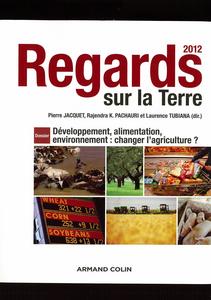Evolution des habitudes alimentaires en Inde et en Chine
Zhou, Zhang-yue, Liu, Hong-Bo, and Gandhi, Vasant P. (2012) Evolution des habitudes alimentaires en Inde et en Chine. In: Jacquet, Pierre, Pachauri, Rajendra, and Tubiana, Laurence, (eds.) Developpement, Alimentation, Environnement: changer l'agriculture. Armond Colin, Paris, France, pp. 204-206.
![[img]](https://researchonline.jcu.edu.au/26015/1.hassmallThumbnailVersion/26015_Zhou_2012.jpg)
|
Image (JPEG) (Book Cover)
- Cover Image
Download (325kB) |
|
|
PDF (Published Version)
- Published Version
Restricted to Repository staff only |
Abstract
Nourrir les populations de l'Inde et de la Chine est un defi qui interesse depuis longtemps Ies penseurs et chercheurs du monde entier. En 2010, ces deux pays comptaient r~spectivement 1,19 et 1,34 milliard d'habitants, soit environ deux cinquiemes de Ia population mondiale. D'apres les previsions, ces chiffres continueront a augmenter, depassant au total3 milliards d'habitants en 2050. Jusqua present, la production alimentaire nationale a permis de nourrir~ces populations. Cependant, revolution rapide des modes de consommation liee au developpement economique souleve de nombreuses questions : dans quelle mesure les habitudes de consommation changent -elles ? Ces changements augmentent-ils la demande en nourriture et en aliments de meilleure qualite ? L'lnde et la Chine pourront-elles continuer a produire assez de nourriture ? Quel sera l'impact des nouveaux modes de consommation sur les marches mondiaux et la securite alimentaire ?
| Item ID: | 26015 |
|---|---|
| Item Type: | Book Chapter (Later Edition) |
| ISBN: | 978-2-200-27528-0 |
| Keywords: | food consumption, changing patterns, China, India |
| Related URLs: | |
| Additional Information: | Title [English]-Changing Patterns of food consumption in India and China Abstract [English] Feeding the populations of India and China is a challenge that has long captivated the interest of thinkers and researchers worldwide. In 2010, India and China's populations reached 1.19 and 1.34 billion respectively, accounting for around two-fifths of the global population. Expectations are that these figures will continue to rise, exceeding a combined total of 3 billion by 2050. The fact that both countries have largely managed to feed their populations with domestically produced food represents a remarkable achievement. However, recent economic development has generated rapid transformations in food consumption patterns that have raised many questions, including: In what way are consumption patterns changing? Will such changes result in a greater demand for food and for higher quality food? Can India and China continue to produce enough food? What impact will changing consumption patterns have on global markets and food security? |
| Date Deposited: | 18 Apr 2013 04:19 |
| FoR Codes: | 14 ECONOMICS > 1402 Applied Economics > 140201 Agricultural Economics @ 70% 14 ECONOMICS > 1402 Applied Economics > 140299 Applied Economics not elsewhere classified @ 30% |
| SEO Codes: | 91 ECONOMIC FRAMEWORK > 9102 Microeconomics > 910201 Consumption @ 20% 83 ANIMAL PRODUCTION AND ANIMAL PRIMARY PRODUCTS > 8303 Livestock Raising > 830301 Beef Cattle @ 80% |
| Downloads: |
Total: 262 Last 12 Months: 6 |
| More Statistics |



